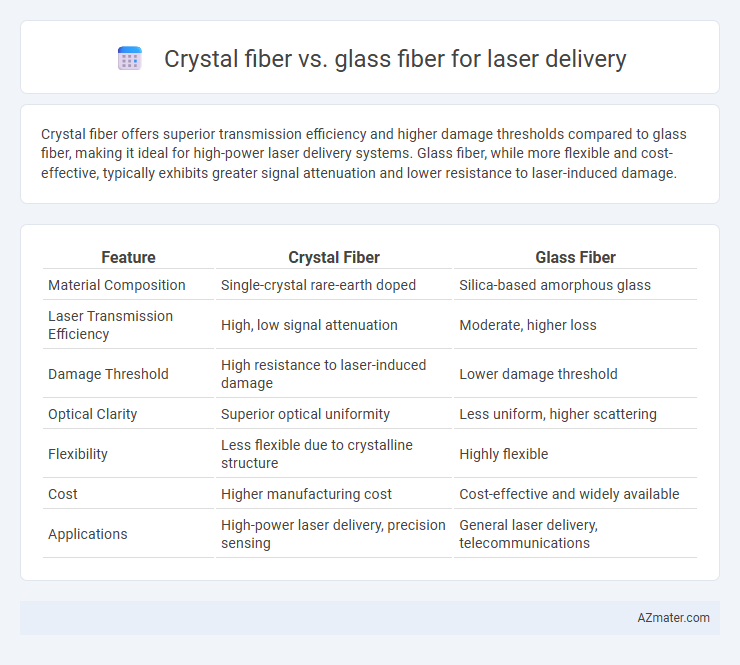Crystal fiber offers superior transmission efficiency and higher damage thresholds compared to glass fiber, making it ideal for high-power laser delivery systems. Glass fiber, while more flexible and cost-effective, typically exhibits greater signal attenuation and lower resistance to laser-induced damage.
Table of Comparison
| Feature | Crystal Fiber | Glass Fiber |
|---|---|---|
| Material Composition | Single-crystal rare-earth doped | Silica-based amorphous glass |
| Laser Transmission Efficiency | High, low signal attenuation | Moderate, higher loss |
| Damage Threshold | High resistance to laser-induced damage | Lower damage threshold |
| Optical Clarity | Superior optical uniformity | Less uniform, higher scattering |
| Flexibility | Less flexible due to crystalline structure | Highly flexible |
| Cost | Higher manufacturing cost | Cost-effective and widely available |
| Applications | High-power laser delivery, precision sensing | General laser delivery, telecommunications |
Introduction to Laser Delivery Systems
Crystal fiber and glass fiber are essential components in laser delivery systems due to their unique optical properties and transmission capabilities. Crystal fibers, often made from synthetic materials like sapphire or yttrium aluminum garnet (YAG), provide superior laser damage thresholds and excellent beam quality for high-power laser applications. Glass fibers, typically fused silica-based, offer flexibility, lower cost, and efficient transmission for lower power laser delivery, making the choice dependent on the specific laser wavelength, power level, and application requirements.
Overview of Crystal Fiber Technology
Crystal fiber technology leverages single-crystal materials, such as yttrium aluminum garnet (YAG) or sapphire, to guide laser beams with minimal nonlinear distortion and high damage thresholds, enhancing laser delivery precision. Unlike conventional glass fiber, crystal fibers exhibit superior thermal conductivity and lower intrinsic scattering losses, enabling high-power laser transmission with reduced signal degradation. This advanced fiber design supports applications requiring efficient wavelength conversion, ultrafast pulse delivery, and high-power laser systems in medical, industrial, and scientific fields.
Fundamentals of Glass Fiber in Laser Applications
Glass fiber for laser delivery operates by guiding light through a core with a lower refractive index cladding, relying on total internal reflection to minimize signal loss and maintain beam quality. These fibers are typically made from silica-based materials, offering high transparency in the near-infrared spectrum, robustness against thermal effects, and resistance to mechanical stress, which are crucial for stable laser transmission. The fundamental advantages of glass fiber include low attenuation rates, precise mode control, and compatibility with various laser wavelengths, making them ideal for industrial, medical, and communication laser applications.
Transmission Efficiency: Crystal Fiber vs Glass Fiber
Crystal fiber exhibits superior transmission efficiency compared to glass fiber, particularly in mid-infrared laser delivery applications, due to its lower intrinsic absorption and scattering losses. The high purity and controlled crystalline structure of crystal fibers enable minimal signal attenuation and enhanced power handling capabilities. Glass fibers, while more common and cost-effective, suffer from higher transmission losses in certain wavelengths, making crystal fibers the preferred choice for precise laser delivery systems requiring optimal energy conservation.
Power Handling Capabilities
Crystal fibers demonstrate superior power handling capabilities compared to glass fibers in laser delivery, enabling higher peak power transmission with reduced nonlinear effects and damage thresholds. Their enhanced thermal conductivity and lower phonon energy contribute to improved resistance against photodarkening and thermal damage at elevated power levels. Glass fibers, while cost-effective and widely used, exhibit lower damage thresholds and higher susceptibility to nonlinear effects, limiting their performance in high-power laser applications.
Spectral Range and Wavelength Compatibility
Crystal fiber offers a broader spectral range and higher wavelength compatibility compared to glass fiber, making it ideal for precise laser delivery applications across ultraviolet to mid-infrared wavelengths. Glass fiber, while cost-effective and widely used, typically supports narrower spectral bands and has limitations in transmitting high-power laser beams at specific wavelengths. The superior nonlinearity and transmission efficiency of crystal fiber enable enhanced performance in advanced photonics and laser system deployments.
Flexibility and Mechanical Durability
Crystal fiber demonstrates superior flexibility compared to glass fiber, allowing it to bend with smaller radii without compromising optical performance. Mechanical durability in crystal fiber is enhanced due to its robust lattice structure, which resists micro-cracking and deformation under stress. In contrast, glass fiber tends to be more brittle, making it more susceptible to damage during bending and repeated mechanical handling in laser delivery applications.
Thermal Management and Damage Threshold
Crystal fiber exhibits superior thermal management compared to glass fiber due to its higher thermal conductivity, enabling efficient heat dissipation during high-power laser delivery. Glass fibers generally have a lower damage threshold, making them more susceptible to nonlinear effects and laser-induced damage under intense irradiation. The enhanced damage threshold of crystal fibers supports higher laser power transmission with reduced risk of fiber degradation, critical for high-performance laser systems.
Cost Analysis and Availability
Crystal fiber offers higher precision and lower transmission loss for laser delivery but typically comes at a significantly higher cost due to complex manufacturing processes. Glass fiber is more widely available and cost-effective, making it the preferred choice for large-scale applications despite slightly higher attenuation. Availability of glass fiber benefits from well-established production and distribution channels, ensuring quick procurement and replacement options.
Application Suitability and Future Trends
Crystal fiber offers superior transmission efficiency and higher damage thresholds, making it ideal for high-power laser delivery in precision medical and industrial applications. Glass fiber remains widely used due to its cost-effectiveness and flexibility, suitable for telecommunications and low-to-mid power laser systems. Advances in crystal fiber technology are driving future trends towards enhanced nonlinear optical properties and broader wavelength transmission, enabling next-generation ultrafast and high-power laser applications.

Infographic: Crystal fiber vs Glass fiber for Laser delivery
 azmater.com
azmater.com